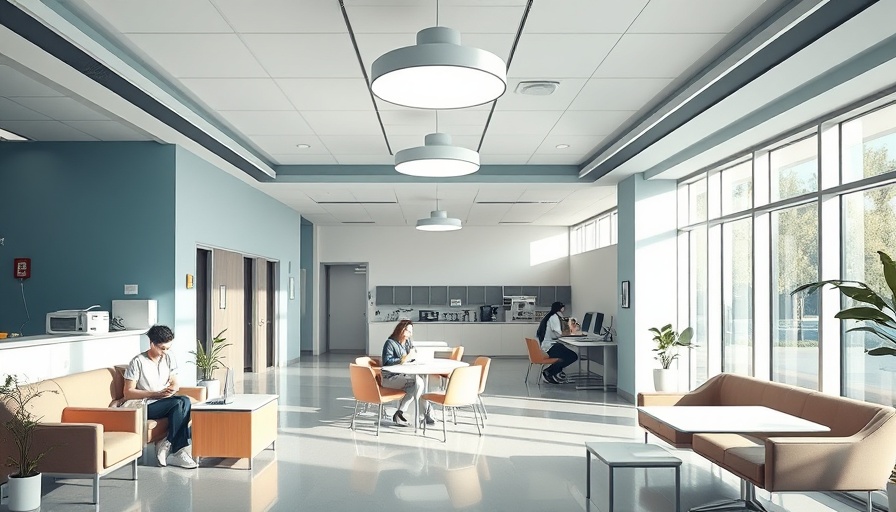
The Growing Issue of Burnout in Healthcare
The healthcare community is currently facing a critical issue: the burnout of its professionals. According to the American Medical Association, while there has been a slight decrease in physician burnout rates in recent years, the numbers remain alarmingly high. Burnout not only affects the mental health and satisfaction of healthcare staff but also jeopardizes the quality of patient care. Understanding how facility design can alleviate this persistent problem is essential for healthcare administrators and facility managers.
Designing Spaces That Heal
To combat burnout effectively, a holistic approach is necessary, one that integrates thoughtful design and self-regulation techniques for healthcare staff. A well-designed facility can enhance operational efficiency, reduce stress, and boost overall job satisfaction. The key is creating a supportive and aligned environment that caters to the specific needs of both staff and patients.
Critical Design Considerations for Health Facilities
When planning renovations or new healthcare facilities, the focus should be on designing environments that prioritize prevention rather than simply recovery. Here are several insightful design strategies that cater to both occupational wellness and patient experience:
Universal Room Layouts
Implementing universal design layouts can vastly streamline critical areas within healthcare settings. By ensuring that equipment and supplies are consistently located, the cognitive load on healthcare workers is significantly reduced, allowing them to focus on patient care instead of searching for tools. This predictability enhances workflow efficiency and ultimately reduces stress.
Workflow-Driven Department Designs
To further decrease burnout rates, it's vital to design departments that consider workflow. Positioning materials and supplies in close proximity to nurse stations reduces travel distances and physical strain. This thoughtful layout helps healthcare professionals remain focused, enabling them to deliver exceptional care while also caring for their own well-being.
The Disney Model: Elevating the Experience
Drawing inspiration from the Disney model can transform interactions within healthcare facilities. By strategically managing the flow of team members and patients, designers can create zones that separate high-stress areas from calming environments. Just as Disney parks skillfully design experiences with distinct ‘on-stage’ and ‘off-stage’ areas, healthcare facilities can design spaces that help alleviate stress for both staff and patients.
Ergonomic Workstations: A Must for Health
Healthcare professionals often endure long hours on their feet, making ergonomic workstations essential. Providing adjustable and supportive furniture can help prevent physical strain and fatigue, allowing workers to maintain healthy posture throughout their shifts. These considerations not only enhance comfort but also reduce the potential for repetitive stress injuries.
Resiliency and Break Rooms for Recovery
Lastly, creating dedicated areas for staff relaxation is crucial. Break rooms designed with calm, welcoming elements can encourage employees to recharge away from high-pressure environments. Such spaces promote a culture of well-being, ensuring that caregivers can return to their duties refreshed and ready to support patients effectively.
The Bigger Picture: Cultural Impact of Facility Design
Facility managers and healthcare administrators must recognize that the culture within a healthcare institution is deeply intertwined with its physical environment. By consciously designing spaces that promote wellness, facilities not only combat burnout but also create a more fulfilling atmosphere for employees and patients alike.
Looking Forward: Creating Sustainable Solutions
As we move forward, it's essential to integrate sustainable and non-toxic materials into healthcare designs. By prioritizing wellness throughout the creation and renovation processes, the healthcare industry can evolve to support the diverse needs of its professionals. Identifying and incorporating evidence-based design principles will become increasingly important in maintaining a resilient workforce while enhancing patient outcomes.
Conclusion: Taking Action Through Design
Facility design plays a pivotal role in addressing burnout in the healthcare sector. By employing strategies that include universal layouts, workflow-oriented spaces, and ergonomic solutions, healthcare organizations can foster environments that prioritize well-being. As facility managers and healthcare leaders, it is time to reimagine our spaces — aiming for not only functionality but also emotional support for all who rely on these environments.
Remember, the spaces we create today will shape the future of healthcare professionals and patient experiences tomorrow. Let’s make that future as bright and supportive as possible!
 Add Row
Add Row  Add
Add 






Write A Comment